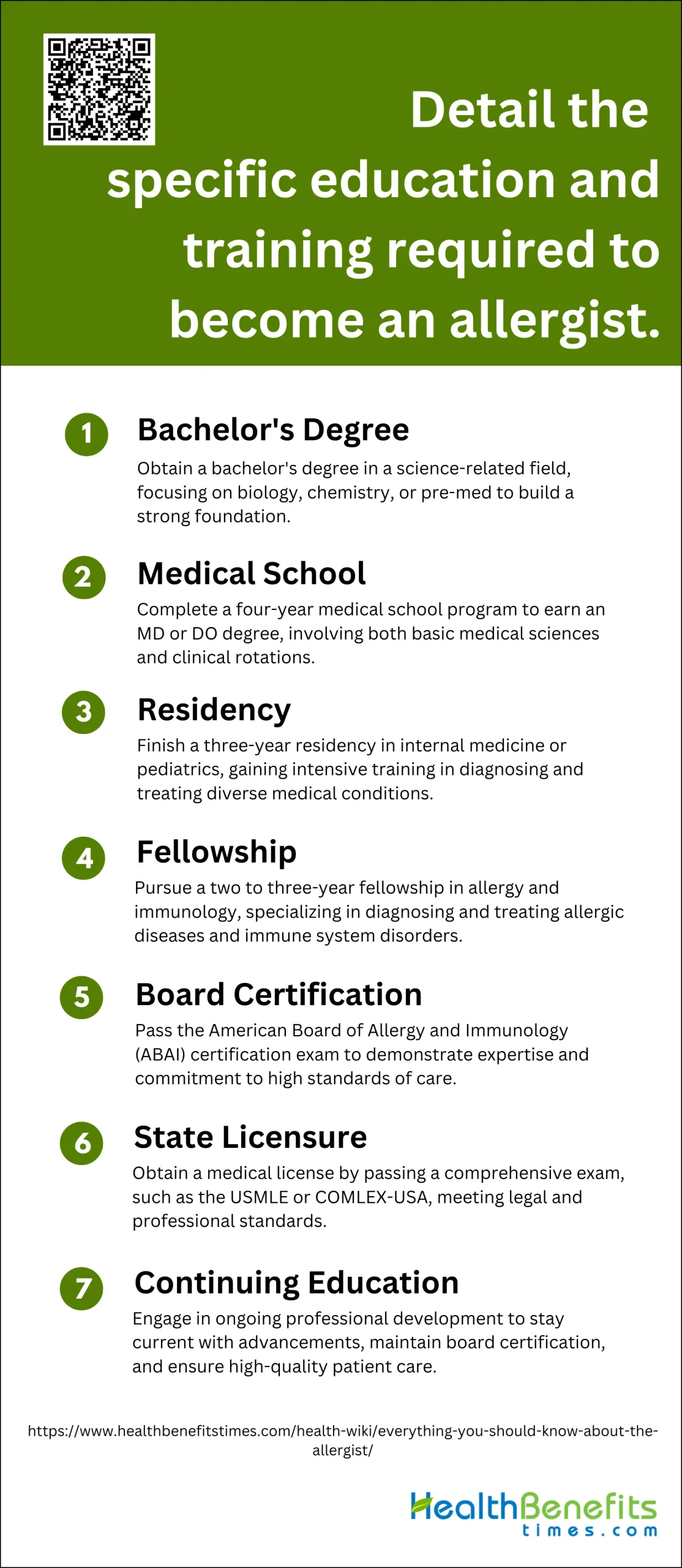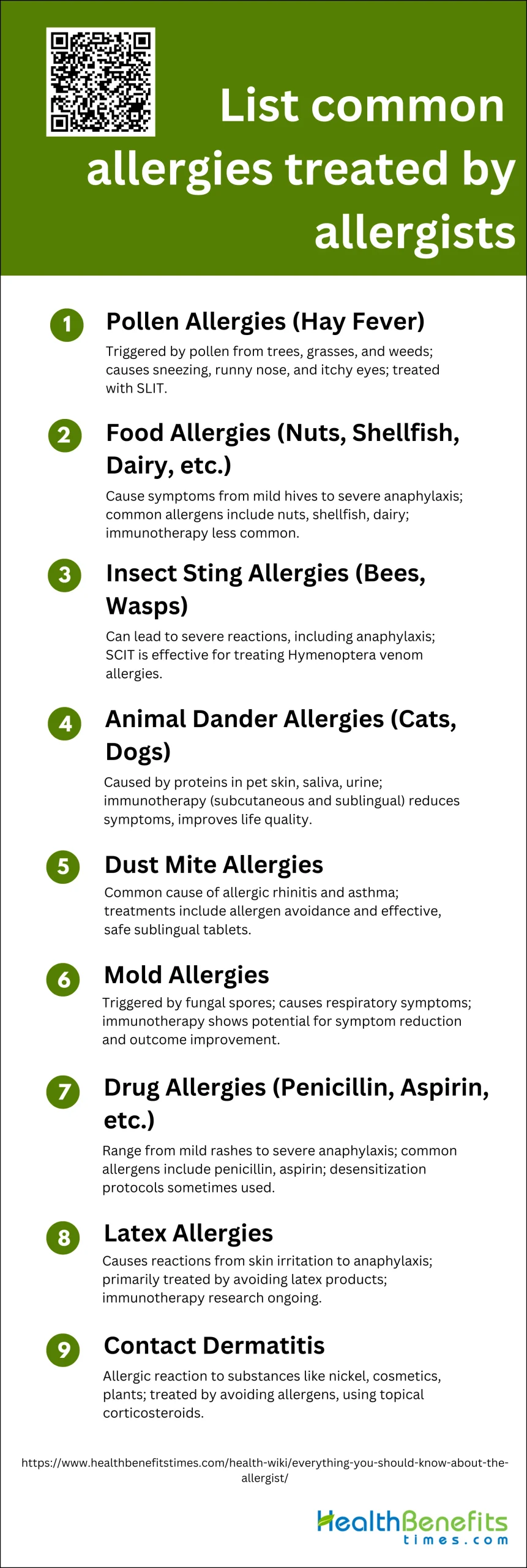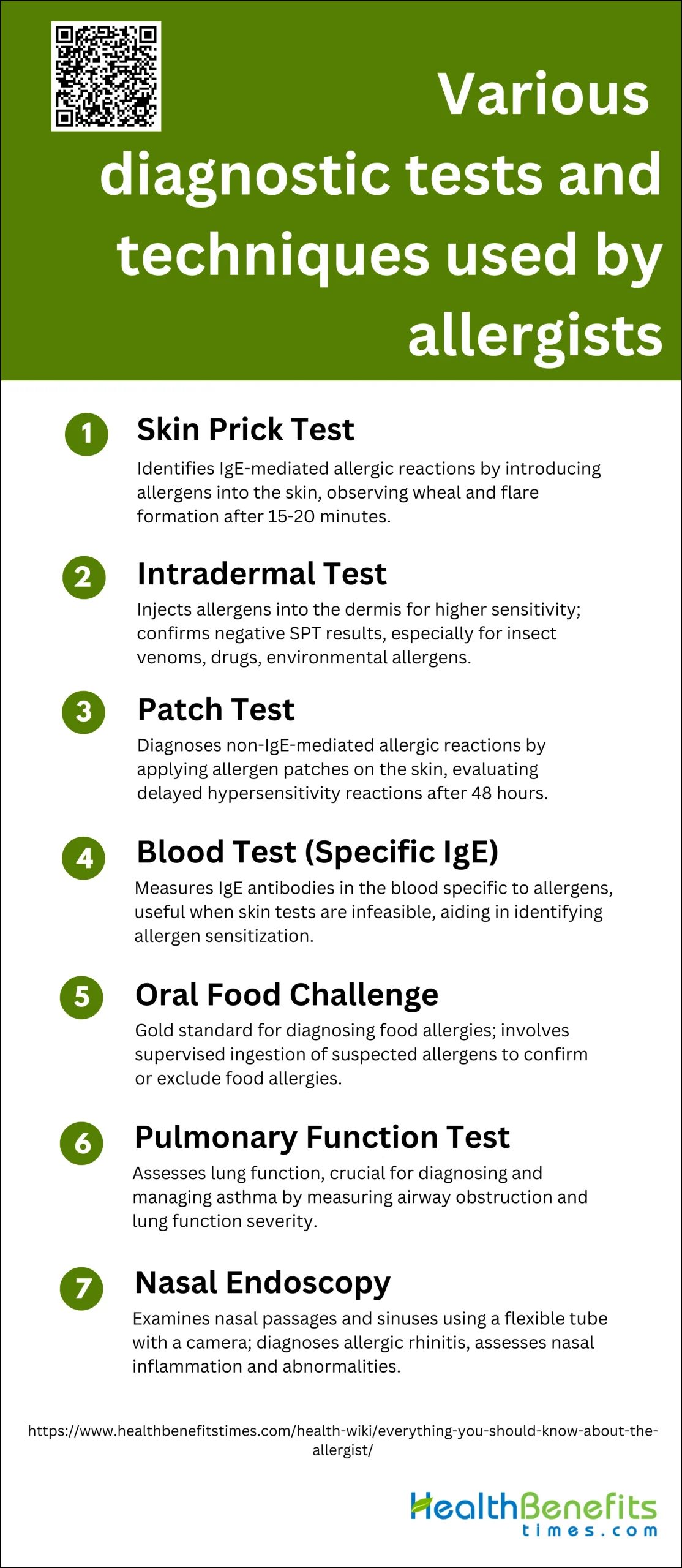![]() What is an Allergist?
What is an Allergist?
An allergist is a medical specialist who diagnoses, treats, and manages allergies, asthma, and other immune system disorders. They are trained to identify the causes of allergic reactions, such as food, environmental factors, and medications, and to develop personalized treatment plans that may include medications, immunotherapy, and lifestyle adjustments. Allergists play a crucial role in managing conditions like anaphylaxis, eosinophilic esophagitis, and vaccine-related allergies, ensuring patient safety and improving quality of life through preventive care and education.
What does an allergist do?
An allergist is a health expert who has undergone extensive training in allergy and immunology, often following a foundational training period in internal medicine, pediatrics, or a related sub-specialty. Their primary role involves diagnosing and managing allergic diseases and immune system disorders. Allergists are adept at identifying external triggers that cause allergic reactions and are skilled in administering appropriate treatments, including immunotherapy and medication management. They play a crucial role in managing conditions such as asthma, allergic rhinitis, anaphylaxis, and food allergies, often working with high-risk groups to improve patient outcomes through preventive strategies and education. Additionally, allergists contribute significantly to public health by developing guidelines for the management and prevention of allergic diseases and participating in clinical research to advance treatment options. Their expertise is also vital in managing complex cases like eosinophilic esophagitis and alpha-1 antitrypsin deficiency, where they provide specialized care and screening.
Detail the specific education and training required to become an allergist.
Detailing the specific education and training required to become an allergist involves understanding the extensive academic and professional journey necessary for this medical specialty. Aspiring allergists must complete several stages of education and training to gain the expertise needed to diagnose and treat allergic conditions effectively. The following steps outline the essential requirements:
1. Bachelor’s Degree
To become an allergist, the first step is obtaining a bachelor’s degree, typically in a science-related field such as biology, chemistry, or pre-med. This foundational education provides essential knowledge in biological sciences, which is crucial for understanding the complexities of human physiology and disease mechanisms. A strong academic performance during this period is important for gaining admission to medical school. Additionally, students often engage in extracurricular activities, such as volunteering in healthcare settings or participating in research projects, to strengthen their medical school applications and gain relevant experience.
2. Medical School
After completing a bachelor’s degree, aspiring allergists must attend medical school, which typically lasts four years. The first two years generally focus on basic medical sciences, including anatomy, biochemistry, pharmacology, and pathology. The latter two years involve clinical rotations in various medical specialties, providing hands-on experience in patient care. This period is crucial for developing a broad understanding of medicine and honing diagnostic and treatment skills. Graduates earn a Doctor of Medicine (MD) or Doctor of Osteopathic Medicine (DO) degree, which is a prerequisite for entering a residency program.
3. Residency
Following medical school, the next step is completing a residency program, usually in internal medicine or pediatrics, which typically lasts three years. During this period, physicians receive intensive training in diagnosing and treating a wide range of medical conditions. This experience is vital for developing the clinical skills necessary to manage complex cases. Residents work under the supervision of experienced physicians, gradually taking on more responsibility as they gain confidence and expertise. Successful completion of a residency program is required to pursue further specialization in allergy and immunology.
4. Fellowship
After residency, physicians must complete a fellowship in allergy and immunology, which usually lasts two to three years. This specialized training focuses on diagnosing and treating allergic diseases and immune system disorders. Fellows gain expertise in managing conditions such as asthma, allergic rhinitis, eczema, and food allergies. They also learn to perform and interpret diagnostic tests, such as skin prick tests and pulmonary function tests, and to administer immunotherapy. This period includes both clinical practice and research, preparing physicians to provide advanced care and contribute to the field’s knowledge base.
5. Board Certification
Upon completing a fellowship, allergists must obtain board certification to demonstrate their expertise and commitment to maintaining high standards of care. In the United States, this involves passing the American Board of Allergy and Immunology (ABAI) certification exam. The exam assesses knowledge and skills in allergy and immunology, ensuring that certified allergists are well-prepared to provide specialized care. Board certification is a mark of professional excellence and is often required for employment in hospitals and clinics. It also signifies a commitment to ongoing education and quality improvement.
6. State Licensure
In addition to board certification, allergists must obtain a medical license to practice in their respective states. This involves passing a comprehensive examination, such as the United States Medical Licensing Examination (USMLE) or the Comprehensive Osteopathic Medical Licensing Examination (COMLEX-USA). State licensure ensures that physicians meet the necessary legal and professional standards to provide medical care. Requirements for licensure vary by state, but typically include proof of education, training, and successful completion of the licensing exam. Maintaining licensure requires adherence to state regulations and continuing medical education.
7. Continuing Education
Continuing education is essential for allergists to stay current with advancements in the field and maintain their board certification and state licensure. This involves participating in ongoing professional development activities, such as attending conferences, completing online courses, and engaging in research. Continuing education ensures that allergists remain knowledgeable about the latest diagnostic techniques, treatment options, and best practices in patient care. It also fosters a commitment to lifelong learning and professional growth, which is crucial for providing high-quality care to patients with allergic and immunologic conditions.
List common allergies treated by allergists
Allergists specialize in diagnosing and managing a wide range of allergic conditions. These conditions can significantly impact a person’s quality of life if left untreated. Below is a list of common allergies that allergists frequently treat:
1. Pollen Allergies (Hay Fever)
Pollen allergies, also known as hay fever or allergic rhinitis, are triggered by pollen from trees, grasses, and weeds. Symptoms include sneezing, runny nose, and itchy eyes. Sublingual immunotherapy (SLIT) has been shown to significantly reduce symptoms and medication requirements for pollen allergies.
2. Food Allergies (Nuts, Shellfish, Dairy, etc.)
Food allergies can cause a range of symptoms from mild hives to severe anaphylaxis. Common food allergens include nuts, shellfish, and dairy. Allergen immunotherapy is less commonly used for food allergies compared to respiratory allergens, but research is ongoing to improve its efficacy and safety.
3. Insect Sting Allergies (Bees, Wasps)
Insect sting allergies can lead to severe reactions, including anaphylaxis. Subcutaneous immunotherapy (SCIT) is particularly effective for treating allergies to Hymenoptera venom, such as bee and wasp stings, and is considered a pivotal treatment for severe reactions.
4. Animal Dander Allergies (Cats, Dogs)
Animal dander allergies are commonly caused by proteins found in the skin, saliva, and urine of pets like cats and dogs. Allergen immunotherapy, including subcutaneous and sublingual methods, has shown promise in reducing symptoms and improving quality of life for those with animal dander allergies.
5. Dust Mite Allergies
Dust mite allergies are a common cause of allergic rhinitis and asthma. Treatments include allergen avoidance and immunotherapy. A 300 IR sublingual tablet has been proven effective and safe for treating house dust mite-induced allergic rhinitis.
6. Mold Allergies
Mold allergies are triggered by spores from fungi and can cause respiratory symptoms. Immunotherapy for mold allergies is less studied but has shown potential in reducing symptoms and improving patient outcomes.
7. Drug Allergies (Penicillin, Aspirin, etc.)
Drug allergies can range from mild rashes to severe anaphylaxis. Common drug allergens include penicillin and aspirin. While allergen immunotherapy is not commonly used for drug allergies, desensitization protocols are sometimes employed in clinical settings.
8. Latex Allergies
Latex allergies can cause reactions ranging from skin irritation to anaphylaxis. Avoidance of latex-containing products is the primary treatment, but research into immunotherapy for latex allergies is ongoing.
9. Contact Dermatitis (Allergic Reactions to Substances like Nickel, Cosmetics, etc.)
Contact dermatitis is an allergic reaction to substances such as nickel, cosmetics, and certain plants. Treatment typically involves avoiding the allergen and using topical corticosteroids to reduce inflammation.
Various diagnostic tests and techniques used by allergists
Allergists employ a variety of diagnostic tests and techniques to identify and manage allergic conditions effectively. These methods range from simple skin tests to more complex blood tests and imaging techniques. Below is a list of common diagnostic tests and techniques used by allergists:
1. Skin Prick Test
The Skin Prick Test (SPT) is a widely used diagnostic tool for identifying IgE-mediated allergic reactions. It involves introducing a small amount of allergen extract into the upper layers of the skin using a needle. A positive reaction is indicated by the formation of a wheal and flare at the test site, typically measured after 15-20 minutes. SPT is particularly useful for diagnosing allergies to aeroallergens, foods, insect venoms, and certain drugs. It is the initial technique for detecting the presence of IgE and is more specific but less sensitive than intradermal testing. Standardization of the procedure and allergen panels is crucial for accurate diagnosis and comparison across different geographic locations.
2. Intradermal Test
The Intradermal Test (IDT) involves injecting a small amount of allergen into the dermis layer of the skin. This test is more sensitive than the Skin Prick Test but less specific, making it useful for confirming negative SPT results. The IDT is particularly effective in diagnosing allergies when the SPT results are inconclusive. It is commonly used for detecting allergies to insect venoms, drugs, and certain environmental allergens. The test results are interpreted based on the formation of a wheal and flare, similar to the SPT, but the reaction is typically more pronounced. Proper training and experience are essential for accurate administration and interpretation of IDT results.
3. Patch Test
The Patch Test is used to diagnose non-IgE-mediated allergic reactions, particularly in conditions like atopic dermatitis and eosinophilic esophagitis. It involves applying patches containing allergens to the skin, usually on the back, and leaving them in place for 48 hours. The test sites are then evaluated for delayed hypersensitivity reactions, such as eczematous lesions. Patch testing is especially useful for identifying food allergies that are not detected by SPT or IDT. Combining patch tests with other diagnostic methods, such as specific IgE measurements, can enhance the accuracy of food allergy diagnosis.
4. Blood Test (Specific IgE)
Blood tests for specific IgE involve measuring the levels of IgE antibodies in the blood that are specific to particular allergens. These tests, such as the Pharmacia UniCAP® and ADVIA Centaur®, provide critical information for diagnosing allergic diseases. They are particularly useful when skin tests are not feasible, such as in patients with extensive eczema or those taking medications that interfere with skin testing. Blood tests can help identify sensitization to a wide range of allergens, including foods, inhalants, and insect venoms. The results must be interpreted in conjunction with clinical symptoms to differentiate between sensitization and true allergy.
5. Oral Food Challenge
The Oral Food Challenge (OFC) is considered the gold standard for diagnosing food allergies. It involves the supervised ingestion of gradually increasing amounts of the suspected allergen under medical supervision. The test is designed to provoke a controlled allergic reaction, allowing for the confirmation or exclusion of a food allergy. OFCs are essential for diagnosing both IgE-mediated and non-IgE-mediated food allergies. They are particularly useful when other diagnostic tests, such as SPT, IDT, or specific IgE measurements, provide inconclusive results. The procedure is time-consuming and carries a risk of severe allergic reactions, necessitating its performance in a controlled medical setting.
6. Pulmonary Function Test
Pulmonary Function Tests (PFTs) are used to assess lung function and are particularly important in diagnosing and managing asthma, a common allergic condition. These tests measure various aspects of lung function, including the volume of air a person can exhale and the speed of exhalation. PFTs help in identifying airway obstruction and assessing the severity of asthma. They are often used in conjunction with other diagnostic tests, such as SPT or specific IgE measurements, to provide a comprehensive evaluation of allergic respiratory conditions. Regular monitoring of lung function through PFTs is crucial for effective asthma management and treatment adjustment.
7. Nasal Endoscopy
Nasal Endoscopy is a diagnostic procedure used to examine the nasal passages and sinuses. It involves the insertion of a thin, flexible tube with a camera (endoscope) into the nasal cavity. This technique is particularly useful for diagnosing allergic rhinitis and other nasal conditions. Nasal endoscopy allows for direct visualization of the nasal mucosa, identification of structural abnormalities, and assessment of inflammation. It can also aid in the collection of nasal secretions for further analysis, such as measuring eosinophil levels or specific IgE. This procedure is often used in conjunction with other diagnostic tests to provide a comprehensive evaluation of nasal allergies.





